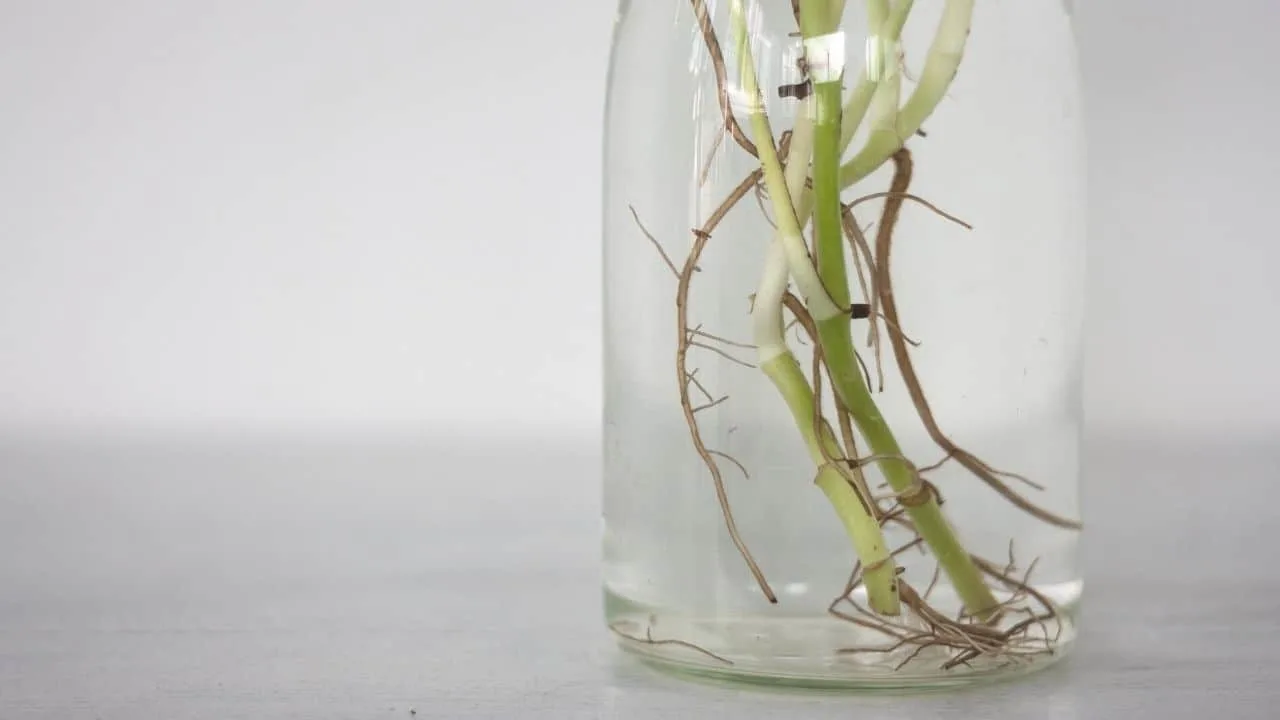Pothos is a great indoor plant, they belong to the ivy family and flourish as hanging plants. While you may think that they need lots of water, it might surprise you that it is very easy to overwater your pothos.
As a result, your plant will die off slowly.
Table of Contents
How to Save Your Overwatered Pothos
The most important step to save your overwatered pothos is to remove excess water to prevent root rot. If the soil is still too damp, carefully remove the pothos root ball and replant it. If your pothos suffers from root rot, trim the vines as close to the root as possible and place the trimmed vines into water.
What Happens When You Overwater Your Pothos

Watering Pothos
I like to have pothos as potted plants because I’ve found them to be very sturdy plants. Even so, if you overwater your pothos, they can suffer from root rot and die.
Root rot happens when the soil in your pot retains moisture for too long. This can be due to overwatering or poor drainage.
If your pothos is overwatered the soil becomes a conduit for decay. The roots of your pothos will begin to die.
Once you have root rot, you need to trim your pothos and sprout new roots.
While root rot can be difficult to spot if your pothos has leaves that are beginning to turn yellow or brown, you should check the soil. You want to remove these leaves before the damage continues to spread through the plant.
If you need to sprout new leaves, you need to have a healthy vine to do so from.
How to Save Your Overwatered Pothos
There are a few ways that you can save your overwatered pothos. The method that you need to use all comes down to the timing and how long your pothos plant has been subjected to standing water.
First, treat the soil. You want to make sure that the soil can properly drain, standing water and added moisture leads to rot.
If the soil is too damp, either remove some of it and replace it or rotate it with new soil. Be careful here.
When changing the soil of your plant you need to be sure to remove the full root ball. Otherwise, you risk killing the plant.
Adding dry soil can dispense moisture. I’ve found that it is a good rule of thumb with this method to not water for a few weeks.
Lastly, if your pothos plants are showing signs of root rot, such as discolored or dying leaves, it’s time to sprout new roots.
Select a healthy vine, one that has no discolored or dead leaves, and cut it as close to the soil as possible. Place the vine in a jar or glass full of water.

Roots Sprouting from Trimmed Pothos Plant
After a few days, the vine should’ve begun to sprout roots. Once there are visible roots, plant the pothos in potted soil.
Best Conditions for Pothos to Grow
Pothos is an ivy-like plant that is native to Southeast Asia. Pothos plants are very common houseplants as they are quite low-maintenance plants.
When caring for your pothos there are conditions that you should keep in mind.
Pothos are plants that do best in bright sunlight. If you do not have a spot in your house with constant light, I’ve found that rotating your pothos or placing them in an area of medium light, helps them flourish.
Among the various concerns that plague a pothos plant, the most common is overwatering. Pothos should be watered once or twice a week.
When the soil’s dry upon touching it, you’ll have to water your pothos. If your pothos is overwatered you risk the plant dying.
Root rot is a common problem that is the result of overwatering. Once root rot has set in, you need to sprout new roots.
Frequently Asked Questions About How to Save Your Overwatered Pothos
How do I tell if my pothos plants are overwatered?
The easiest way to identify an overwatered pothos is if the soil remains saturated and the water doesn’t drain. If there’s standing water left in the dish under your pot, drain it and wait for your soil to dry out. Leaves that are either browning or dying are also a good indicator that your pothos is getting too much water.
How do I save my pothos afflicted with root rot?
When it comes to root rot, you will need to sprout new roots. Root rot affects the entire plant, first by weakening it and, as a result, the plant will die. You can still save your pothos before it gets to that point. A great thing about pothos is that they’re easy to sprout.
If my pothos plant is dying, how can I make a new plant?
One of the reasons that pothos are such great house plants is that you can easily sprout a new plant if needed. Due to their nature of being easily sustainable to root rot, being able to sprout new roots is great. You simply need to cut a vine and place it in a glass of water to sprout a new pothos plant.
In Conclusion
If you accidentally overwater your pothos, don’t throw the plant out. There are different methods that you can take to save the plant.
First, you should drain any excess water and not water the plant until the soil has dried. If that tactic doesn’t work, you can overturn the soil or re-pot your pothos.

Daniel has been a plant enthusiast for over 20 years. He owns hundreds of houseplants and prepares for the chili growing seasons yearly with great anticipation. His favorite plants are plant species in the Araceae family, such as Monstera, Philodendron, and Anthurium. He also loves gardening and is growing hot peppers, tomatoes, and many more vegetables.


